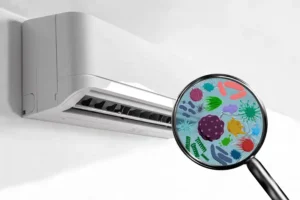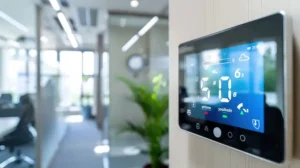Blog Contents
- 1 How Ceiling Fans Work With Your Heating & Cooling System
- 2 Fan Direction Matters: One of the Most Common Mistakes
- 3 Clearing Up Energy Efficiency Myths
- 4 Where Ceiling Fans Work Best
- 5 When Ceiling Fans Help—and When They Don’t
- 6 Simple Tips for Getting the Most From Your Ceiling Fans
- 7 How B&H Can Help You Maximize Home Comfort
Let’s clear something up right away: ceiling fans aren’t just for summer. Used the right way, they can help your home feel more comfortable year-round—and even give your HVAC system a little break in the process.
For many homeowners, ceiling fans are one of the most overlooked (and underused) tools for maintaining comfort and managing energy costs.
When you combine fans with smart thermostat settings, they can make your home feel cooler in the summer, cozier in the winter, and more efficient all around.
How Ceiling Fans Work With Your Heating & Cooling System
Ceiling fans don’t actually heat or cool the air—they move it. And that air movement changes how the air feels in your home. When air circulates better, it evens out temperature differences across the room, which helps your heating and cooling system do its job more efficiently.
- In summer: Fans push cooler air downward, creating a gentle breeze that makes you feel several degrees cooler. This allows you to bump up the thermostat without sacrificing comfort.
- In winter: Fans can help recirculate warm air that naturally rises and gets trapped near the ceiling, bringing it back down where you need it most.
The result? Less work for your HVAC system and more comfort for you—if you’re using the fan correctly.
Fan Direction Matters: One of the Most Common Mistakes
The direction your fan spins plays a huge role in whether it’s helping or hurting your comfort.
- Summer setting (counterclockwise): Pushes cool air down, creating that breezy, wind-chill effect.
- Winter setting (clockwise, on low speed): Gently pulls cooler air upward and redistributes warm air back down along the walls.
If you’ve never adjusted your fan’s direction before, look for the small switch on the fan’s motor housing. A quick flip at the start of spring and fall ensures your fans are set for the season.
Clearing Up Energy Efficiency Myths
One of the biggest misconceptions is that fans actually lower the room temperature like an air conditioner. They don’t. Fans make you feel cooler by moving air across your skin. That’s why you shouldn’t leave ceiling fans running in empty rooms—they aren’t cooling the space itself.
When used smartly, though, fans absolutely help you save energy. By raising the thermostat a few degrees in summer (or lowering it slightly in winter), you can cut your energy use while staying comfortable.
Where Ceiling Fans Work Best
Ceiling fans are most effective in the rooms where you spend the most time. Consider adding or using fans in:
- Living rooms: Especially helpful for rooms with high or vaulted ceilings where heat tends to collect.
- Bedrooms: Promote better sleep by keeping air circulating throughout the night.
- Home offices: Help smaller spaces feel fresher without over-relying on the AC.
- Kitchens: Take the edge off when the stove or oven heats things up.
Pro tip: Make sure your fan is properly sized for the room. A fan that’s too small or too large won’t circulate air as effectively.
When Ceiling Fans Help—and When They Don’t
Ceiling fans work great in tandem with your HVAC system, but they aren’t a fix-all solution for every situation.
When fans help:
- On mild days when you want to delay turning on your AC or furnace.
- In rooms with uneven temperatures or limited air vents.
- When you want to give your HVAC system a little support, especially in open floor plans.
When fans don’t help:
- In rooms no one’s using (fans cool people, not spaces).
- In poorly insulated homes where air leaks counteract temperature control.
- When they’re spinning in the wrong direction for the season.
The goal is to use ceiling fans and HVAC together as a team—not one instead of the other.
Simple Tips for Getting the Most From Your Ceiling Fans
Looking to squeeze more comfort and savings out of your system? Try these practical steps:
- Pair fans with your thermostat: Adjust your thermostat slightly while using your fans to maintain comfort without overworking your HVAC.
- Flip fan direction seasonally: Remember to switch fan direction at the start of spring and fall.
- Turn off fans in empty rooms: Save energy by using fans only when people are present.
- Keep fan blades clean: Dust buildup can reduce efficiency and stir up allergens.
- Focus on key living spaces: Install fans where you spend the most time for the best payoff.
A little attention to how you use your ceiling fans can add up to real comfort and real savings throughout the year.
How B&H Can Help You Maximize Home Comfort
At B&H, we look at the whole picture—your HVAC system, ceiling fans, insulation, and everything that affects your home’s comfort and efficiency. Our team helps homeowners find practical ways to stay comfortable while keeping energy costs in check.
Whether you’re looking to upgrade your HVAC, get guidance on fan placement and usage, or explore energy-efficient options for your home, we’re here to help. We’ll work with you to make sure your ceiling fans are part of a bigger, smarter comfort plan.
Ready to feel the difference a well-planned system can make? Contact B&H today for a home comfort consultation!







